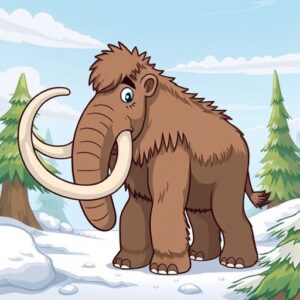
FROZEN GIANTS
The woolly mammoth is an extinct species of elephant that lived during the ice age. They were called “woolly” because they had thick fur to keep them warm in cold places.
We can learn about them from their fossilized skeletons and ancient cave paintings. They lived on Earth 2.6 million years ago, and their fossils have been found on all continents except for Australia and South America.
One mammoth was discovered by a hunter in a cold and dark Siberian cave, where it was so well-preserved in 50-degree frost that scientists could easily identify the food in its stomach.
The word “mammoth” means
“extremely large”, and woolly mammoths were just as big as modern African elephants, weighing about 6 tons. They felt comfortable in frigid climates because of their fur and short ears, which helped them stay warm. The Woolly mammoths had a lump on their backs where they stored fat for energy when food was scarce.
They had long, curved tusks and trunks that they used for moving objects, fighting, foraging for food, and digging under the snow. Adult woolly mammoths could protect themselves from predators with their tusks and trunks. They were herbivores and mainly ate grass and plants.
When the earth began to warm, their habitats were destroyed. Today, they are extinct, but we can still learn about them from modern cartoons.
Scientists are not certain about the real reason for their disappearance. Some believe that people slaughtered them, while others think they could not adapt to the changing environment caused by warming temperatures.



Put the words in the following sentences.
Cave, primitive, survive, ancient, glacier, preserve, slaughter, herbivores, skeleton, environment
1. We must feel obligated to protect the ____ from pollution.
2. The temperature was frigid inside the ____.
3. Some animals cannot ____ in very cold conditions.
4. My teacher told us that sheep and cows are ____.
5. My sister is so thin that you can see her ____ through her skin.
6. My TV is so ____ that I need to get a new one.
7. In villages, pigs and chickens are being fattened for ____.
8. A ____ is an enormous body of ice.
9. It’s our duty to ____ the planet for future generations.
10. The spiny anteater is a mammal, although a very ____ one.
Questions
1. Why did woolly mammoths stay warm in frigid climates?
2. How did woolly mammoths differ from modern elephants in terms of their physical characteristics?
3. What was the role of the lump on the back of woolly mammoths, and how did it help them survive in harsh environments?
4. What are some of the theories about why woolly mammoths were extinct, and what evidence supports each of these theories?
5. What types of tools or weapons did ancient humans use to hunt woolly mammoths, and how did this hunting impact their populations?
6. Can you name any modern animals that share similar traits or characteristics with woolly mammoths?
7. If you had a time machine and could go back to the ice age, what would you like to observe or learn about the woolly mammoth?

ACTIVITIES
Felt Mammoth Bookmark Craft
Materials:
• Gray or brown felt
• Scissors
• Glue
• Black marker or pen
Instructions:
1. Cut a rectangle shape out of the felt to serve as the bookmark base.
2. Cut smaller rectangles or squares out of the felt to serve as the mammoth’s ears.
3. Cut out two larger rectangles to serve as the mammoth’s tusks.
4. Glue the ears and tusks onto the top of the bookmark.
5. Use a black marker or pen to draw eyes, a trunk, and any other details you’d like to add.
6. Let the glue dry completely.
7. Once dry, your mammoth bookmark is ready to use!

Make a Woolly Mammoth Habitat:
Create a diorama of a woolly mammoth habitat. You can use clay, rocks, and other natural materials to create a realistic environment for the mammoths.

